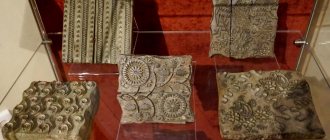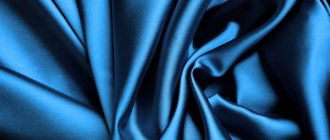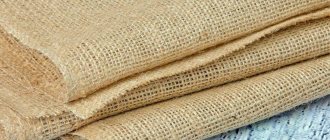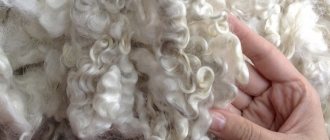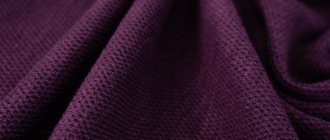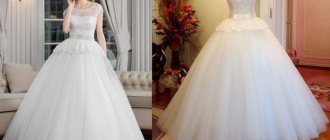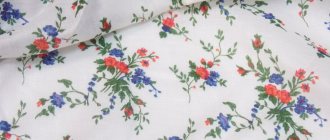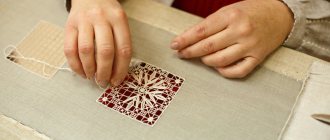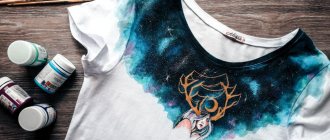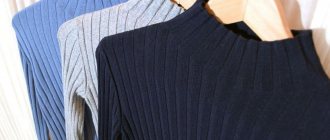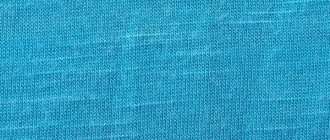What type of fabric is this?
Batiste is a light, airy and delicate fabric woven from thin fibers of cotton, synthetic, viscose and other threads. The most expensive material is made of linen threads.
Linen
Natural linen fabric - from a description of production to a review of characteristics
more details
Despite its fine texture and smoothness, cambric is quite durable. And this is achieved through plain weave. When impurities are added to the composition in the form of other fibers, the material acquires other properties.
Lawn fabric colors
Now cambric production has been established almost all over the world. However, the fabric that is most similar to the original is woven only in Italy, France, and Belgium. In these countries, hand-twisting of flax yarn is still used.
Not everyone can afford to wear products made from such material. And all because flax is grown on plantations specifically for these purposes and is carefully looked after. The result is flax fiber of the highest quality.
In factory production, other fibers are used, for example, synthetic and cotton. Although the fabric loses all its original attractiveness, it acquires other properties, for example, increased wear resistance.
But in this case, increased demands are placed on manufacturing: the fiber must be uniform in thickness over its entire length, only then can a perfectly even structure be obtained. Cotton for these purposes is grown in Peru and Egypt.
How cambric fabrics are made
A distinctive feature of the fabric has always been its smoothness. Batiste is so thin and uniform that perfectly even threads are used for its production. Cotton grown in Egypt and Peru is considered to be of the highest quality.
You might be interested in what is twill satin: description of the fabric and differences from satin
Elite fabric is prepared by hand, however, the hardware fabric turns out to be almost flawless. Painting of ready-made cambric began relatively recently - before that it was considered a symbol of purity and purity. Today you can find a spectacular and attractive print that will satisfy a variety of needs.
Origin story
Baptiste has long been famous for its high cost, dating back to the 13th century. Previously, it was available only to the rich. It was then brought from India. Only the rich could afford to sew underwear, shirts, shirts or other items of clothing from cambric.
Baptiste was not always called that way. Its name was given in honor of the weaver J. Baptiste Cambrai, who in the 18th century unraveled the secret of weaving fibers. Then the material began to be produced in Flanders. In some European countries, the material was also called “cumbric”, this is also in honor of the master.
Since cambric was first made from linen fiber, which was spun by hand, garments made from this material indicated a person from high society. This fabric is even mentioned in some novels by writers of that time.
History of appearance
The cambric was first brought to Europe by Indian merchants. Small quantities of outlandish fabric were brought, and it was quite expensive. The finest handmade product was available only to noble, wealthy European women. Magnificent ball gowns and all sorts of feminine things were made from incredibly beautiful fabric. It was also used to make delicate underwear and bedding.
The presence of the thinnest cambric scarf meant nobility of origin. In the 13th century, the secret of making beautiful fabric was unraveled by the Flemish weaver Jean Baptiste Shamry. We owe the creation of such a masterpiece, incredibly light and translucent, to him. The fabric began to be called after its European founder. However, another name is sometimes used: “cambric”, corresponding to the name Cambrai (the city where its production began).
Fabric composition and its properties
Thin, smooth and airy fabric can consist of fibers of different origins: linen, cotton, viscose or synthetics. The composition may even contain several types of fibers. The properties of the material depend on what they are. For example, synthetics can make cambric stronger and make the product easier to care for.
Properties:
Softness
Ease
Hygroscopicity
Breathability.
Does not cause allergies
Comparison with poplin and satin
Modern types of poplin and satin are created not only from silk fiber, but also from cotton. The main feature and difference of these materials is their pearlescent luster or shimmer. Batiste is a matte fabric, less often it has a slight sheen. All other characteristics and descriptions of the fabrics are largely the same:
- They are dense in structure and perfectly smooth;
- Thin and delicate, suitable for shirts and linen;
- They require careful care, but at the same time remain durable and do not wear out for a long time;
- They look representative and expensive.
You might be interested in What is wet silk: a description of the fabric and decorative wall covering
Pearlescent satin
At the same time, iridescent fabrics look better in evening dresses, while cambric material is a good basis for a neat daytime look.
Types of fabric
Main types:
Bleached
It is the finest snow-white fabric. It is practically lint-free. Soft and tender. Suitable for sewing underwear, children's clothing, wedding dresses.
Plain painted
Painted one color. Used for sewing curtains or bed linen, tablecloths, etc.
Printed
Batiste with a pattern. A variety of designs are applied, from polka dots to flowers. Used for sewing clothes from the summer wardrobe.
Mercerized
Thanks to the mercerization process, in which the fabric is treated with an alkali solution, washed off with hot and cold water, cambric acquires increased density, rich color, silkiness and gloss. The fabric is used to make not only clothes, but also home furnishings.
Jacquard
A jacquard pattern is applied to the fabric and clothes or scarves are sewn from it.
Embroidered
Embroidery is applied to the cambric.
Reviews about the material
Lyudmila: “I’m sewing summer dresses and blouses for myself and my friends, and I’m making cambric. The fabric is inexpensive, durable, and very pleasant to the body. It’s comfortable to work with the material—the stitching lies evenly and it’s easy to cut. In addition, things are ironed and always look beautiful and neat.”
Bright cambric for dresses and blouses
Olga: “I prefer summer clothes made from cambric and satin: the fabrics are light, breathable, and can even be washed by hand. We wash men's shirts of all shades together without any problems. The only downside is that it wrinkles, so it’s not the best option for children’s clothing, but otherwise there are only advantages.”
You may be interested in this Technical characteristics and properties of angora fabric
Tatyana Nikolaevna: “Cambric or chintz makes the most pleasant and durable linen, summer sundresses and shirts. Usually the fabric is painted with a flower pattern, so the outfits look varied. For the summer, you can sew it yourself or buy 2-3 shirts and dresses - that’s your wardrobe for several years to come.”
Material for dresses
The attractive material is affordable and environmentally friendly, so when you have doubts about what fabric to choose for sewing clothes, you can try working with cambric, then not only the result will be pleasant, but also the process itself.
Proper washing of expensive fabrics
To maintain the original appearance of the material, it is necessary to properly care for it. So, cambric requires careful and special care. How to wash cambric without damaging it? It is better to do this manually or, as a last resort, hand wash in a washing machine (after placing it in a special bag that will protect the delicate material from damage). Before washing, all items must be turned inside out, and if there are buttons, fasten them.
Additional rules for fabric care:
- Never wash items made from different materials together.
- Do not use bleach with chlorine. Buy stain removers and bleaches only labeled “for delicate fabrics.”
- Items should be dried flat, but not in the sun. The best option is a shaded place.
Description of the fabric: composition, properties, characteristics
The main raw materials for the production of cambric are cotton and flax. To reduce costs and improve the quality characteristics of the fabric, synthetic elastane fibers are added to the composition. Mixed cambric has high strength and wrinkles less. Italian manufacturers add silk to the composition, from 30 to 50 percent; the cost of such fabrics is high.
The material is characterized by a smooth, even surface, extremely light weight, and delicate texture.
The weight of 1 square meter of cambric is 55-70 grams.
Fabric density - 70 g/m2.
The material is easy to dye and offers a wide range of colors: from restrained soft tones to bright floral prints.
Video: cambric fabric
The video shows two cambric fabrics in coral and blue with a floral print. In the video you can clearly see that the fabric is light and pleasant, even somewhat reminiscent of oil fabric.
See similar articles
- Cotton - natural cotton fabric
- Blackout - light-proof dense fabric for curtains
- Cotton is a popular natural fabric
- Interlock - cotton knitted fabric for children's clothing
- Crepe de Chine - flowing fabric for elegant clothing
- Ribana - knitted fabric, natural and tight
If you liked the article, share it with your friends!
Care Tips
Batiste items require careful handling.
Despite the simple care (does not fade, washes easily and dries quickly), delicate textiles require careful handling. Whether it's a children's shirt or cambric tulle, the rules remain the same:
- gentle wash at a temperature of 30-40 degrees (delicate mode setting);
- spin less than 400 rpm;
- ban on chlorine bleaches;
- dry flat (keep away from direct sunlight);
- wash in a bag (if possible);
- ironing through gauze (“linen”, “cotton” mode).
Before loading into the machine, cambric pillowcases and duvet covers are turned inside out, buttons and zippers are fastened. Repairs are carried out with a sharp needle and thread number above sixty.
If you follow the recommendations, cambric can withstand numerous washes and last a long time without losing its attractive appearance.
Advantages and disadvantages
Based on the description and composition of the material, it is difficult for a person who first encountered it to say how it will manifest itself in everyday wear. Therefore, it is worth noting its positive and negative sides.
The advantages of cambric include:
- breathability of the fabric - in the warm season, clothes made from cambric will not be hot;
- lightness of the material - the fabric is light in weight, so things made from it are practically not felt on the body;
- hypoallergenic - natural cambric does not cause irritation, redness and other adverse reactions in people prone to allergies;
- resistance to deformation - even after numerous washes, the products do not lose their original appearance.
According to its characteristics, the cambric material is a “champion” among other types of fabric. But there are several disadvantages that can be decisive in choosing fabric for sewing a new product.
- Due to the lightness of the material, batiste can cause some difficulties when cutting.
- For the durability of the products, you need to wash things only on a delicate cycle.
- Batiste is most often used for sewing casual clothes. Formal outfits made from it look a little cheap and modest.
Application and advantages.
The following are made from cambric:
- Underwear and bed linen;
- Napkins, handkerchiefs, tablecloths;
- Women's clothing (blouses, dresses, dressing gowns);
- Wedding dresses;
- Women's accessories (gloves, belts, brooches);
- Curtains ;
The list is not exhaustive, however, these products are the most common. If you have anything else made from cambric, we will be glad to hear it in the comments. The main advantages of cambric products are:
- High breathability, it is not hot in summer;
- Low cost;
- Pleasant to the touch;
- Practically does not wrinkle;
- Drapable;
- Does not fit the figure, allowing free movement;
- Very light and airy. It is practically not felt on the body;
- Retains its shape well and does not deform after washing;
- Dries quickly.
How cambric is made
The material is woven from fine twisted yarn in a plain weave. One warp thread overlaps one weft thread. The uniformity of raw fibers is of particular importance for the production of high-quality cambric. The thickness of the threads must be the same along the entire length; thickening, unevenness, and flaws are not allowed.
The yarn is pre-moistened by treating it with glycerin.
The finished fabric is bleached, dyed, and in some cases subjected to mercerization - treatment with alkali.
Well-known manufacturers most often use long-staple cotton from Egypt and Peru to produce cambric.
Production and composition of cambric (from its origins to the present day).
Like most fabrics in the old days, cambric was made by hand. Twisted linen, and sometimes wool, fibers formed the basis of cambric of that time. Of course, today flax is used much less frequently, and production is no longer done by hand. The Industrial Age made its own adjustments to the development of the textile industry. Nowadays, cotton or synthetic fibers are mainly used as raw materials. Sometimes cambric is made mixed or cotton-synthetic. Synthetics are added to increase the strength and wear resistance of the material. The structure of cambric is a plain weave fabric made from twisted threads of the same thickness, both along the warp and weft (you can see the weaving pattern in the photo below).
Plain weave pattern.
The threads must be even along the entire length, without bumps or depressions, otherwise the fabric will not be as good as it should be. Batiste itself is a durable fabric with pleasant tactile properties and good breathability.
Advice: when purchasing a cambric product, be sure to pay attention to the composition of the product, because... very often synthetic cambric is passed off as cotton or linen. Study the product tag carefully and only then proceed to purchase.
Four main types of cambric:
- Plain-dyed cambric is distinguished by a rich, monochromatic color scheme. This type of fabric is most suitable for making bed linen and kitchen tablecloths. The abundance of colors will allow you to easily choose the right color scheme to match your bedroom or kitchen, making it more sophisticated and elegant.
- Printed cambric is a fabric onto which special embroidery or design is applied. The result of this processing is fabric with rich and colorful colors, from which dresses and various outfits are made;
- Merstenized cambric is a very durable material. To increase wear resistance and strength, cambric is treated with caustic soda and then washed with water at different temperatures. The result of such procedures is the “hardening” of the material, which makes it possible to increase wear resistance, which ultimately increases the service life of the product.
- Bleached cambric is a white translucent fabric that is used in the manufacture of children's bedding, wedding dresses, blouses, dresses and much more interesting things.
